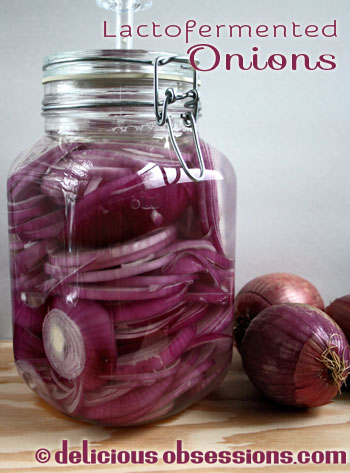FTC Disclosure: Delicious Obsessions may receive comissions from purchases made through links in this article. As an Amazon Associate I earn from qualifying purchases.Read our full terms and conditions here.
I am slooooooowly going through my old ferments and getting them updated for the anaerobic fermenting vessels. I will, at some point, get them all updated. It’s just going to take me awhile! 🙂
I did get my original pickled onion recipe updated and that is what I’m sharing with you this week. This recipe is SO easy! Two ingredients are all you need – onions and brine (I guess brine is technically two ingredients).
You can also make these fancier by adding some garlic or fresh herbs. I meant to add garlic and thyme to my batch, but I was crying so hard by the end of slicing all those onions that I completely forgot. My health food store had a great price on red onions recently, so I stocked up. Those are some of the strongest red onions I’ve ever sliced. I made two slices in my first onion and was already crying! Tears and sharp knives are not a good combo!
If you don’t like red onions, feel free to use a different variety. These “pickled” onions are delicious in salads, on sandwiches, with eggs, on pizza, and more. Really, you can use them any way you would regularly use onions. Delish!
I made a two-liter jar, but you can make more or less, depending on how much you like them. They will last upwards of a year in cold storage, so it’s a great chance to make a big batch. They do get better with age. The picture above I took before the fermenting got underway. I thought they were much prettier at the start than they were once they were fermented. 🙂
Lactofermented Red Onions (Updated for the Anaerobic Jars)
Ingredients
- 5 red onions – mine were on the small/medium side, so you may only need 3 if they’re really big
- Fresh herbs (optional)
- Fresh garlic (optional)
- 2% brine (19 grams of sea salt per 1 quart of filtered water)
Instructions
- Make your brine and let cool to room temperature. For a 2L anaerobic fermenting jar, I needed exactly one quart of brine.
- Slice your onions (have tissues ready, and please, don’t cut yourself!)
- If you are using fresh herbs and garlic, place those in the bottom of the jar. Then pack your sliced onions on top and pack to the shoulder of the jar.
- Add your weight.
- Pour your brine over the onions, filling to the neck of the jar. You want to make sure you leave at least an inch of headroom between the top of the brine and the lid.
- Add your airlock and close the lid. Wrap the jar in a dark towel to keep the light out. UV light destroys all the good little bacteria we’re trying to cultivate!
- Leave at room temperature until the active bubbling stops. Depending on the temperature of your house, this could be anywhere between 5 and 10 days. My house is starting to cool off now that it’s fall, so it took 8 days at room temperature. When the bubbling is done, move to cold storage and enjoy!


45 Comments